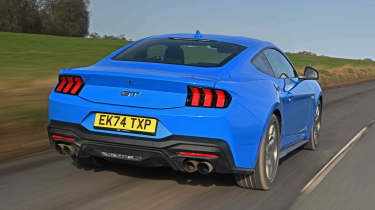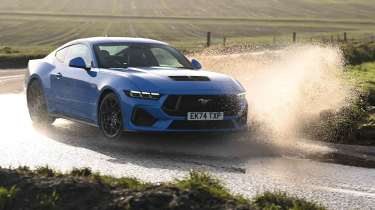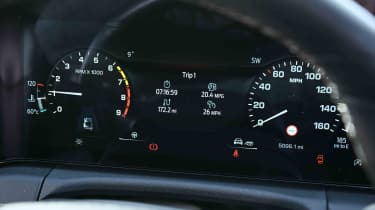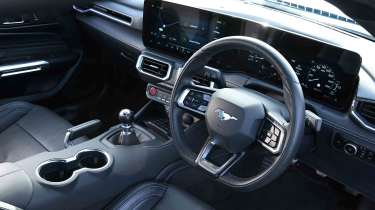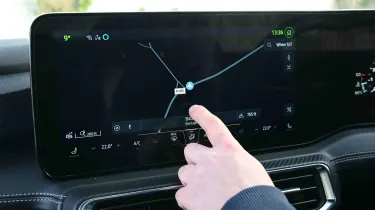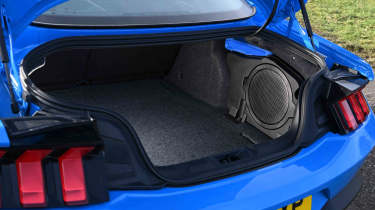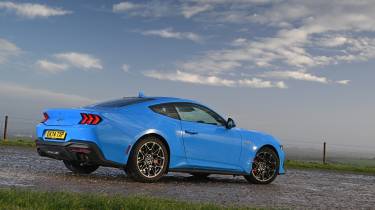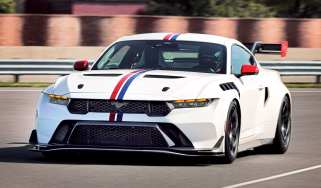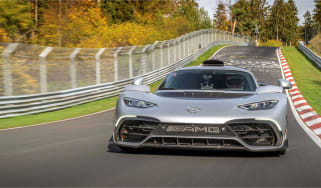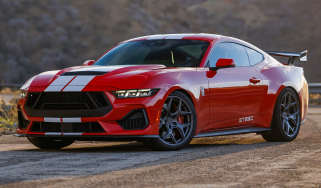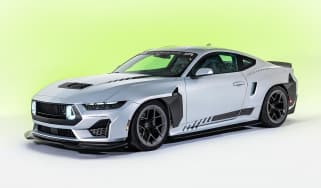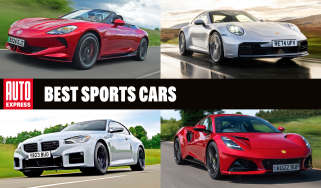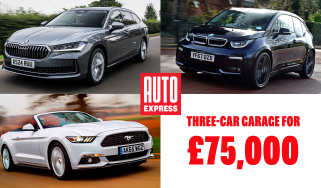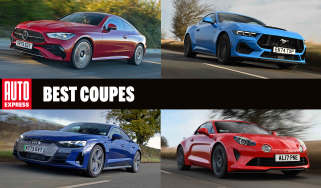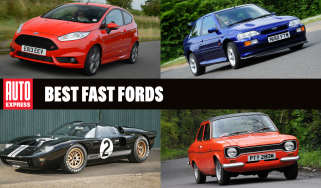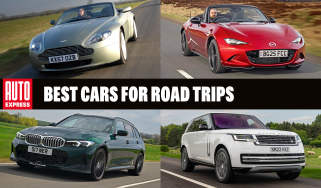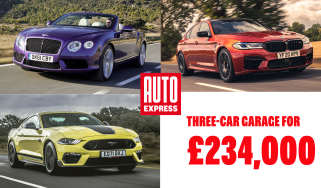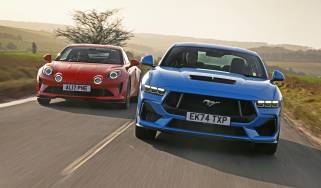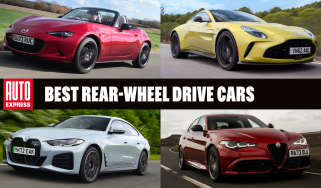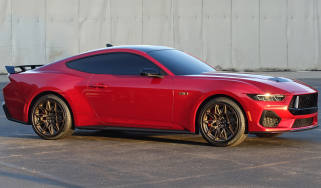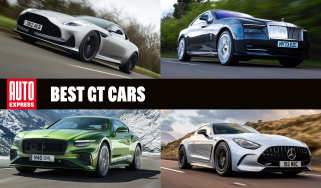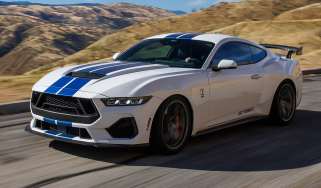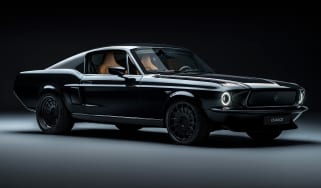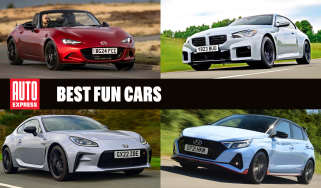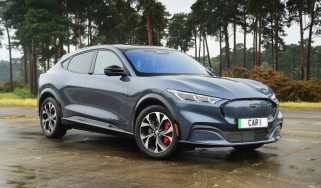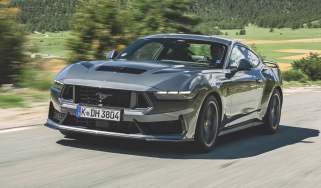Ford Mustang review
Famous Ford Mustang nameplate gets a more aggressive look for its seventh generation

Is the Ford Mustang a good car?
It’s always a tough task to reimagine an icon, but the Ford Mustang Mk7 does exactly that. With buyers easily falling for its predecessor’s looks, the aim was clearly to not tinker with the formula too drastically. The latest model is sharper, more menacing and more angular than the Mk6 generation, but it’s still instantly recognisable as a Mustang.
At a time when so many cars are using turbos or electrification to improve efficiency, the Mustang has stuck with a big, simple V8 engine, driving the rear wheels only. As before, it’s possible to buy a Coupe model or – for a reasonable premium – a Convertible. The Mustang was highly commended in Coupe of the Year category at our 2025 New Car Awards.
| Key specs | |
| Fuel type | Petrol |
| Body style | Two-door coupé, two-door convertible |
| Powertrain | 5.0-litre V8, six-speed manual, rear-wheel drive 5.0-litre V8, 10-speed automatic, rear-wheel drive |
| Safety | Not yet tested by Euro NCAP |
| Warranty | Three years/60,000 miles |
How much does the Ford Mustang cost?
Prices start from around £56,000, which gets you behind the wheel of the 5.0-litre V8 GT coupé, while the Ford Mustang Convertible carries a £3,500 premium over the hard top.
These models feature the same V8 powerplant which makes 440bhp and 540Nm of torque, with all of that power going to the rear wheels via a six-speed manual gearbox, or you can add a 10-speed auto for £2,000 extra.
At the top of the range (aside from the track-focused GTD) is the Ford Mustang Dark Horse, which is around £12,000 more than the GT and only comes as a coupé. It has a bit more power than the standard car, at 447bhp, but torque is the same, while the GT’s standard Getrag six-speed manual is substituted by one made by specialist Tremec. It’s the same gearbox that was used in the previous-generation Ford Mustang Mach 1, and has slightly shorter ratios for faster acceleration.
Used - available now

2019 Ford
Mustang
16,432 milesManualPetrol5.0L
Cash £42,500
2022 Ford
Mustang
17,511 milesAutomaticPetrol5.0L
Cash £37,000
2019 Ford
Mustang
37,000 milesManualPetrol5.0L
Cash £39,990
2022 Ford
Mustang
4,590 milesManualPetrol5.0L
Cash £41,500The last Mustang was offered with a 2.4-litre four-cylinder EcoBoost turbo petrol unit, as found in the Ford Focus RS Mk3, but while that powerplant is available in the US and some other markets, the UK is just getting the traditional 5.0-litre V8 for now.
Ford Mustang history
A few cars can be identified by a single name – Beetle, Golf, Model T – and Mustang is definitely one of them. Originally designed to tap into a market of young drivers looking for a sporty car, the Mustang has evolved over seven generations to become a staple of the new-car market.
The original Mustang was based on existing parts from Ford models, such as the Falcon and Fairlane, which helped keep costs down and made the car affordable. That helped sell a million cars in the first 18 months it was available – pretty impressive when Ford projected sales of 100,000 for the first full year it was on sale in 1965.
Over the years, the Mustang has grown in size and power, with models such as the Mach One, Cobra, Boss 302 and Boss 429, not to mention the Shelby variants, all adding performance to the basic package.
There was a failed attempt to sell the Mustang in the UK back in the eighties, although it faced internal competition from the Ford Capri that it could never match, but the Mustang finally officially arrived in right-hand drive guise in 2016.
Engines, performance & drive
The heart of any American muscle car is its engine, and the Mustang has a very big heart. The 5.0-litre naturally aspirated ‘Coyote’ V8 puts out a very healthy 440bhp in GT spec, or 7bhp more in the more focused Dark Horse. Of course, all that shove is backed up by plenty of torque, too, with both versions offering 540Nm. In GT form, that’s enough to reach 0-62mph in 5.4 seconds, with the Dark Horse arriving at the benchmark 0.1 seconds sooner.
That isn’t far shy of the 473bhp offered up by the BMW M2 – and that car costs nearly £12,000 more than the Ford; the BMW doesn’t sound as good, either. Even when you’re plodding along in traffic or gently cruising up to 3,000rpm before each upshift, there’s a growl from the Ford’s engine which constantly reminds you that you’re driving something very special. Rev matching is very easy when changing down, but there is a switchable automated system that can do this for you, too.
Use all of the power that the Ford has to offer, and it begins to roar as it nears the red line. Some previous Mustangs have a slightly harder edge to their tone than the latest model, but there’s still so much pleasure to be had from extracting everything that the V8 can offer. Upshifts need to be well considered during hard driving, because aggressive changes can cause the rear axle to spin up – especially in the damp. In a time of charmless turbo engines and electric powertrains, the Mustang never fails to put a smile on your face.
There is one very big exception to all of this, however, which is the automatic gearbox. The optionally available transmission has a baffling 10 speeds, and with so many ratios to choose from, the engine is never given the chance to extend itself. Each upshift is accompanied by a drop in revs so small that you’d be forgiven for thinking that there’s a CVT gearbox hiding in the car, making that V8 feel completely flat.
Even if you seize manual control, there are so many gears that it’s hard to keep up with which one you’ve chosen. Don’t be tempted by the fact that the auto accelerates slightly quicker than the manual – if you need an auto in your performance car, look elsewhere.
On the road, the Mustang gets a lot of things very right – and very little wrong. It’s composed yet comfortable, exciting yet refined: Ford has settled upon a really well judged set-up.
Prod the round starter button at the base of the dashboard, and the deep burble from the V8 could leave some Mustang newbies feeling slightly intimidated about how tricky it might be to drive such a burly coupé. The first few miles behind the wheel, however, will ease their minds completely. While the clutch pedal and gearshift require some positivity, they’re slick and precise to use. There’s enough heft to reassure you that it’s engineered to cope with the engine’s torque, but it’s significantly lighter than earlier Mustangs and its rivals from 10 to 15 years back.
That engine has so much grunt from low down that low-speed manoeuvres and plenty of traffic jam crawls can be carried out on just the biting point of the clutch – often there’s no need to even tickle the throttle pedal.
The Mustang surprises on a twisty road, where there’s a level of precision and delicacy to its chassis that gives some of the best European coupés a run for their money. The nose is keen to dive towards an apex, with steering that is well judged in terms of its response, weight and accuracy.
Body movement is fairly well contained, even on tricky roads. It’s only when it’s pushed very hard on the most challenging roads that the ultimate sharpness fails to live with a BMW M2 or Porsche Cayman – and its fairly substantial mass starts to reveal itself.
Grip and traction are impressive, while the overall balance is neutral. Almost too much so: for a V8-powered coupé, the torque feels pegged back at the lower reaches of the rev range, so it means that trying to adjust the mid-corner balance on the throttle has less effect than we’d like. The brakes are more than up to the task of hauling the car to a stop.
The Mustang’s centre console houses what looks like a manual handbrake, but it’s actually electric. By selecting an Electronic Drift Brake mode on the infotainment screen, the rear brake pressure is preloaded so that a tug on the lever locks the back axle to initiate a handbrake turn.
We drove the car on public roads, so we couldn’t put the theory to the test, but we weren’t keen on the way the lever is sprung. Rather than gradually building resistance like a regular handbrake, it feels initially heavy with little effort needed after.
For all its ability as a driver’s car, the Mustang’s credentials as a long-distance cruiser manage to exceed even those high standards – this is a model that really lives up to its GT billing. Regardless of whether you’re driving around town or at motorway speeds, the ride is impressively soothing, which, combined with the car’s big, soft seats, makes it a very comfortable place to complete lengthy journeys. The gearing in sixth is very long, which means at 70mph the engine is pulling less than 2,000rpm.
| Model | Power | 0-62mph | Top speed |
| Mustang 5.0 GT | 440bhp | 5.3 seconds | 155mph |
| Mustang 5.0 Convertible auto | 440bhp | 5.0 seconds | 155mph |
| Mustang 5.0 Dark Horse | 447bhp | 5.2 seconds | 155mph |
MPG, emissions & running costs
People don’t buy a V8 American muscle car expecting it to sip fuel like a Toyota Prius. In certain situations, the Mustang works its way through unleaded as keenly as you’d expect, and in even fairly free-moving urban traffic, expect low-twenties mpg at best.
But on more open roads, things improve. That torquey engine that makes motorway trips feel so effortless – and the long sixth gear that means it’s barely ticking over at 70mph – ensures that it will achieve more than 30mpg.
Cruising range is harmed by its average-sized 61-litre fuel tank, and while 300-ish miles will be fine at a cruise, work the car harder and you’ll be making regular fill-ups.
Whether you’re a company car user or a private buyer, road duty for the Mustang is about as high as it’s possible for it to be. From April 2025, VED rates are set to double across almost every band; with the Mustang’s CO2 emissions of 275g/km already putting it in the highest Band K, that will see its first year cost rising from £2,745 to £5,490. After that, the cost will be £600 a year.
Depending on which model you choose, the Ford Mustang line-up sits between insurance groups 43 and 46.
Residual values are fairly strong across the Mustang range. The GT coupé is expected to retain roughly 56 per cent of its value after three years or 36,000 miles, while the Convertible will hold on to 53 per cent. The Dark Horse version looks set to resist depreciation the best, keeping 58 per cent of its original asking price.
| Model | MPG | CO2 | Insurance group |
| Mustang 5.0 GT | 28.0mpg | 230g/km | 44 |
| Mustang 5.0 Convertible auto | 27.4mpg | 235g/km | 48 |
| Mustang 5.0 Dark Horse | 27.2mpg | 238g/km | 46 |
Design, interior & technology
Blending retro design and modern tech is a tough challenge, and in some areas the Mustang succeeds in this better than others.
Ever-growing digital displays make the Ford short of the clear retro feel in some of its predecessors, but a chunky-looking steering wheel and lots of Mustang logos add some sense of occasion. The shoulder line of the windows is fairly high as you sink into the large, supportive seats, so you still feel snugly cocooned within something clearly sporty.
Ford Mustang buyers have always had to concede some build quality in order to get a keenly priced coupé with a big engine, and while the new car feels reasonably well finished, there are still a few too many hard, cheap-feeling plastics dotted around to make it feel truly luxurious.
In some ways, Ford has done a great job of bringing the Mustang’s cabin into the 21st Century while leaving subtle references to its past. For example, the digital gauges can be customised to show the driving information in many ways, with track mode offering a huge, horizontally scrolling rev counter.
You can even make your new Mustang resemble past models. Among the options are gauges aping those of the 1967 model, a 1987 Fox Body or even a 2000s-era SVT Cobra.
Sat-nav, stereo and infotainment
A huge 13.2-inch screen dominates the Mustang’s dashboard and it uses the latest version of Ford’s SYNC software, with some Mustang-specific content thrown in. Squeezing the bespoke features into the standard interface has added confusion, though; the My Mustang menu lets you customise colours and graphics for the dials, yet some other display settings are where they are in other Fords, which puts them in a completely different sub-menu. One positive is that it’s amazingly quick and easy to pair a Bluetooth device.
While much of the infotainment mirrors that of other Fords, the Mustang has a few unique menus. You can display auxiliary gauges on the touchscreen, to give real-time readouts for oil pressure, lateral G and battery voltage. Find a private road, and you can record your own 0-62mph attempts via the built-in acceleration timer.
The GT comes with a 10-speaker B&O sound system. Even though it’s having to fight with the bass from the V8 engine, it sounds punchy and clear – better than the premium systems you’ll get in a BMW M2 or Porsche Cayman.
Boot space, comfort & practicality
While practicality will never be at the forefront of a coupé buyer’s checklist, those looking for a desirable two-door performance car that has space for a young family of four would struggle to do better than the Mustang.
The high dashboard line and long bonnet add a sense of occasion to the Mustang’s cabin, but the upshot is that judging the car’s extremities needs careful consideration in tight spots. It’s easy to get comfortable, though, because the seats are supportive. They also have plenty of adjustment, and so does the steering wheel.
The Mustang’s rear seats can be genuinely usable. Against the tape measure, while headroom is a little tight, the cut-out in the roof line at the leading edge of the rear windscreen means that it offers roughly the same space as the BMW iX2 coupé-SUV.
Predictably, it’s knee space which is most at a premium, because if the driver’s seat is set all the way back, it’s touching the rear seat squab. But with an average-sized driver (or shorter), there’s enough space to carry adults. The seats are very sculpted and supportive.
At 408 litres, boot capacity is very reasonable for a performance car. The opening isn’t huge, but the space is more than a metre long and almost one metre wide, so there’s room for golf clubs, or even suitcases.
| Dimensions | |
| Length | 4,810mm |
| Width | 1,916mm |
| Height | 1,404mm |
| Number of seats | Four |
| Boot space | 381 litres |
Safety & reliability
The latest Mustang hasn’t been tested by Euro NCAP yet, but the Mk7 gets much more safety tech than its predecessor. A lane-keep assist system can be switched off easily via a button on the steering wheel, but the speed-limit warning system needs to be disabled via an infotainment sub-menu. The Mustang also has a system that alerts the driver if they’re not holding the steering wheel. Our test car often failed to register that we had both hands on the wheel, and only a vice-like grip would satisfy it.
Owners ranked Ford 30th out of 32 brands in our 2024 Driver Power owner satisfaction survey. Among its results were 31st place in the ride and handling section and 27th in the powertrains category – so it’s safe to say that those areas of feedback don’t apply to the Mustang’s excellent chassis and V8 engine.
All new Fords have a three-year, 60,000-mile warranty, although there aren’t many rivals to the Mustang that offer more comprehensive cover.
Maintenance costs aren’t as cheap as most new Fords you can buy today. A three-year Ford service plan with a 7,000-mile annual mileage limit costs just over £1,000.
| Key standard safety features | Euro NCAP safety ratings |
|
|
Ford Mustang alternatives
The number of new V8-powered front engined, rear-wheel drive coupés for sale in the UK amounts to one, and the Mustang is it. However, change the number of cylinders to six, or even four, and there are options to be found. The BMW M2 is pricier and more engaging to drive, or there are the four-cylinder versions of the BMW 2 Series that could be considered, plus the BMW Z4 roadster.
Another rear-drive coupé that’s available, albeit hard to come by new, is the Toyota GR86, which is lighter and more agile, and lacks the soundtrack a Mustang delivers. Or there’s the Toyota Supra, which has the same six-cylinder engine as the Z4. A left-field option is the Alpine A110, or entry versions of the Porsche Boxster and Cayman. If you’re looking for an open-top cruiser, then the Mercedes CLE Cabriolet can fill that brief, although again it’s pricey when compared with the Mustang.
Frequently Asked Questions
The current Mustang is an evolution of the sixth generation, so there should be good reliability from the proven parts under the skin. Ford’s ‘Coyote’ 5.0-litre V8 is a fairly common unit that can even be bought direct from Ford in the US for customisers wanting to modify their own cars.

